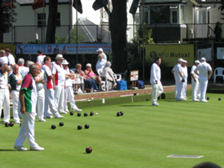Article 2 - Re-Testing Lawn Bowls
ARTICLE 2 - Testing
Bowls (Originally published in 1997 and revised in 2009)
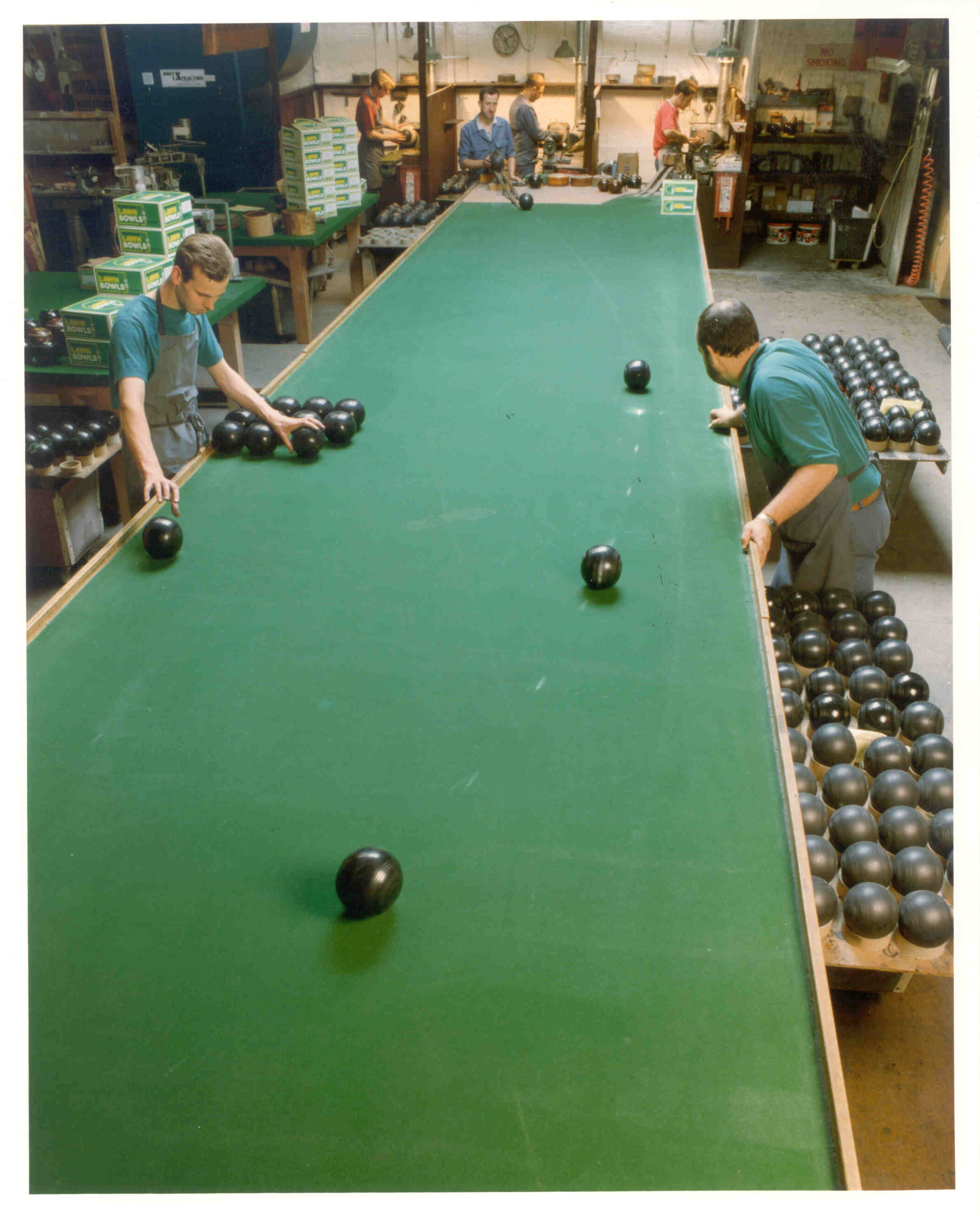
a view of the Drakes Pride test table
In my first article, I mentioned the importance of 1871 - well
that was the year that Taylor's of Glasgow constructed the first
testing table. I understand, from speaking to Noel Taylor that the
idea was to allow the company to produce matched bowls from their
factory rather than waiting for the customer's vague instructions
and comments as to their requirements.(I should mention here that
unless otherwise stated this article refers to the bias for lawn
bowls and the authorities for that discipline)
A test table allows the production of bowls that perform on the
test table (note the wording 'on the test table') in a given manner
and at that time these were specified as number 1 bias through to
number 5 bias. Number 1 bias being the weakest and number 5 the
strongest. But when the Scottish Bowls Association carried out
their testing, they were then able to agree upon a bias strength
and thus in 1893 adopted the number 3 biassed bowl as their
'Standard'.
I am sure that there are a lot of bowlers who will remember the
reference to number 3 bias, which was still regularly mentioned up
to a few years ago. Crown green bowlers will also note that their
standard was selected using the same five biases and that the
number 2 was considered not strong enough, but number 3 bias was
too strong. Thus,2 full or slightly stronger than 2 bias was
selected. I have not been able to find any information as to the
date when the crown green bias was selected.
Interestingly in further research during 2002 confirmation of
the 1 bias to 5 bias still being available in the 20th Century was
found in a circa 1906 catalogue. A copy of the page is shown
below.
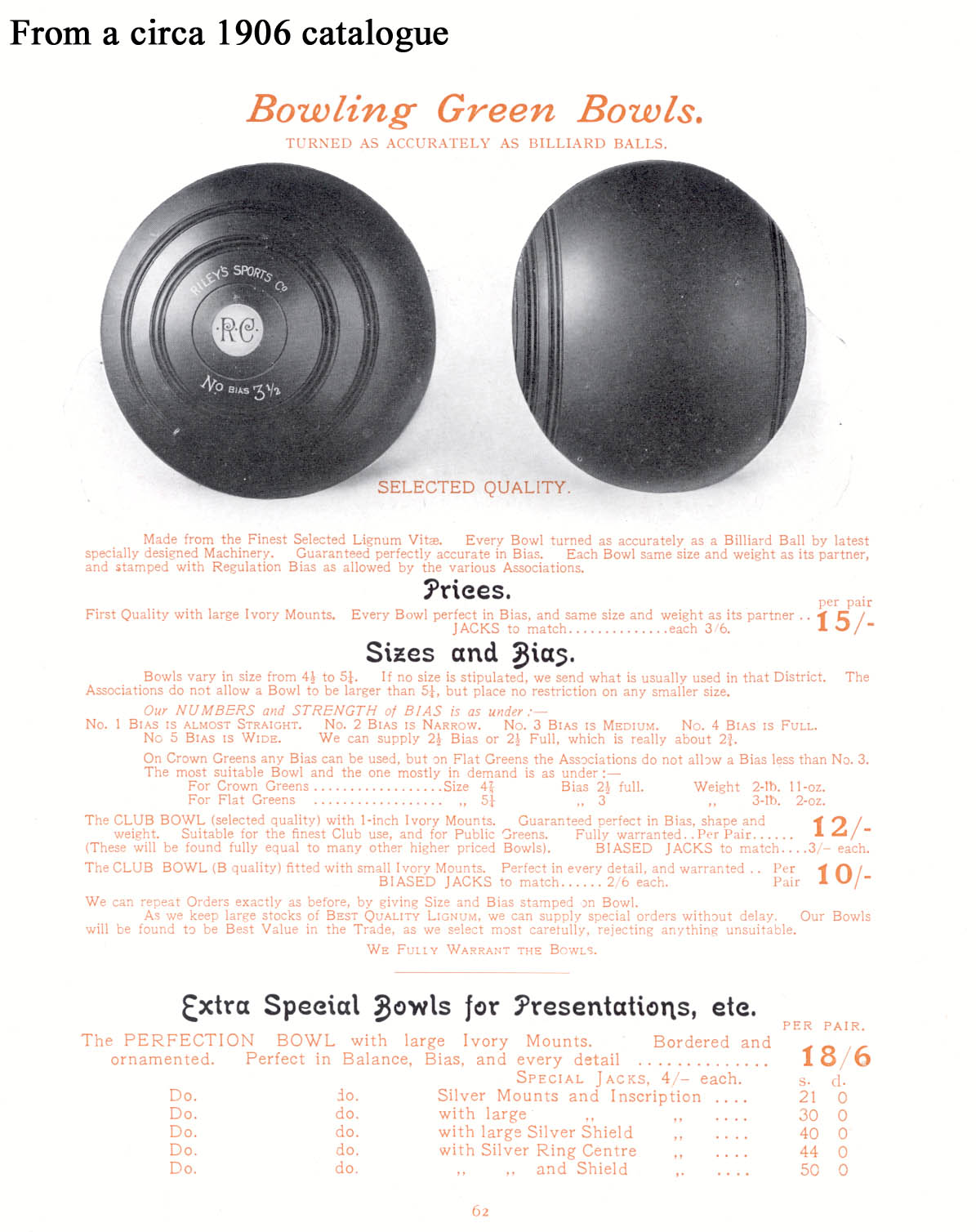
The next picture is taken from a 1935 price list of Taylor-Rolph
and still lists 5 strengths of bias. However it is interesting to
note that biases 1 through to 2 ½ are notes as Crown Green
Bias.
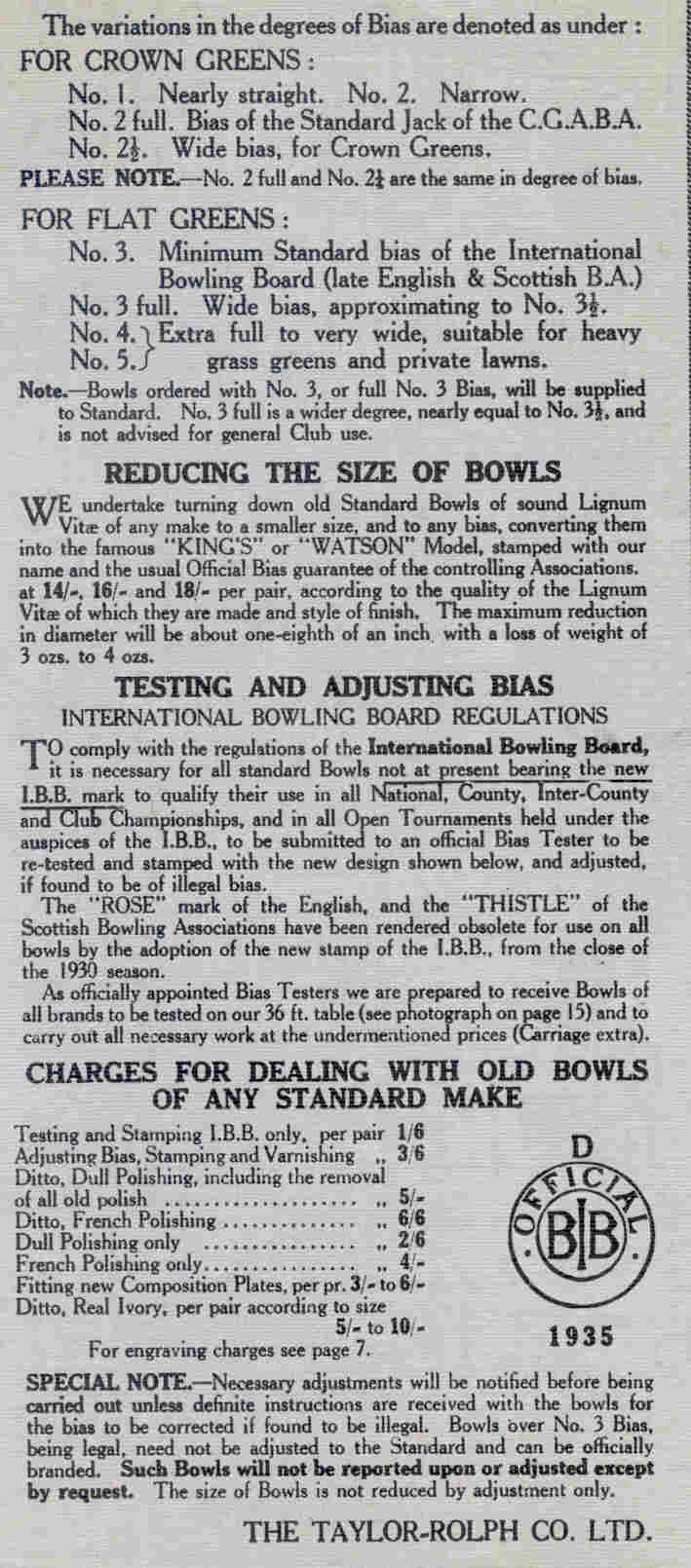
Nearly all test tables have been and are based on standard
billiard/snooker tables, because of their rigidity of construction
and the accuracy of level that the slate bed can achieve. Thurston,
Drakes Pride sister company, has in fact installed a number of
these test tables both in the UK and Australia, and so they are
considered to be the experts on test tables. In the Hensell booklet
"The Romance of a Bowls Manufacturer" it mentions the fact that W.
D. Hensell tested bowls originally on a standard (12ft) billiard
table, but in 1908 developed a 36ft test table. This basically
would be achieved using three full size billiard tables placed end
to end, the cushions being removed to give one long table. Perhaps
it is worth mentioning that there is a remarkable association
between Bowls manufactures and Billiards. It was whilst working for
the Australian Billiard business of Alcock Thomson & Taylor
that Hensell first worked on bowls.
In 1928 an attempt was made to lay down test table performance
so the fact that in the 1935 Taylor- Rolph catalogue they showed
their test table indicates the significance placed on the means and
method for testing.
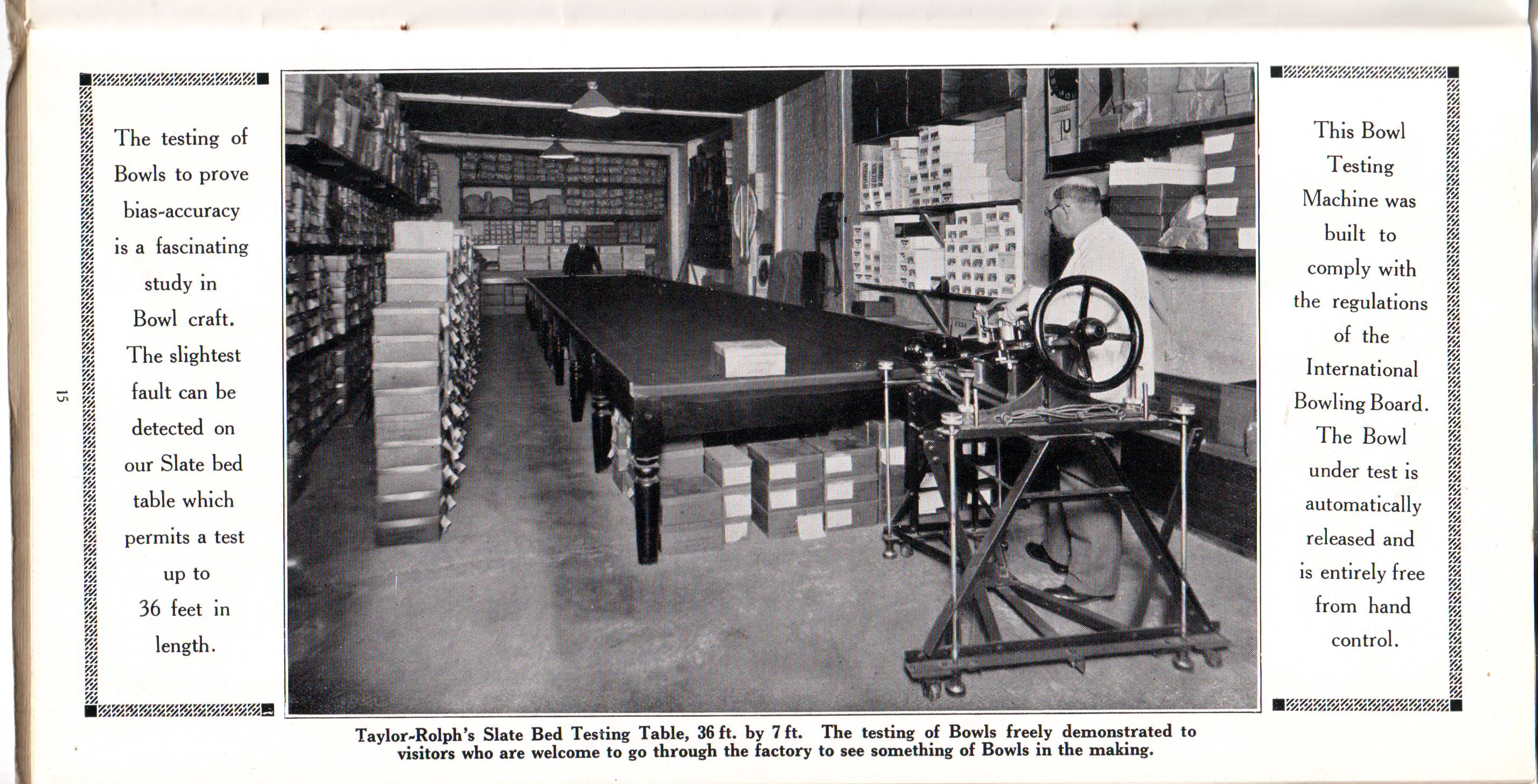
In 1928, the I.B.B. (International Bowls Board changed to World
Bowls Board and currently the World body is - World Bowls Ltd.)
laid down the basis for table testing (See drawing and the
specifications, which with a few amendments are basically still
true today. For example, the bowls should still run approximately
28 feet, themaximum draw shall be approximately
4'6 however, one important addition to the specifications is that
the running time should be between 12 - 15 seconds.(note on 2002
the governing body of Lawn Bowls ,World Bowls Ltd., laid down
regulations which stipulated that the length of run was 9
metres)
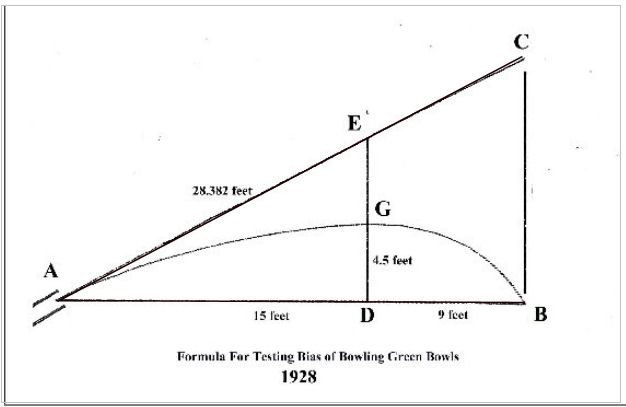
1928 Dia. For Bias Testing
NOTES TO ACCOMPANY THE REGULATIONS FOR TABLE TESTING OF
BOWLS
The I.B.B. Official Bias Testers formula for testing in October
1928 set out the following points :
(a) For the purpose of accurate testing the table must consist
of an impervious material so that it would be independent of the
variations of temperature.
The cover to be made of the same texture throughout without
joins. We suggest that this should be obtained from the I.B.B, thus
ensuring that all tables will be covered by the same cloth, no
other fabric being permissible for testing purposes.
(c) That a straight line A - C of 28.302ft be drawn to extend
from the middlepoint of the mouth of the chute and parallel to both
it sides.
(d) "A" being starting point of the bowls contact with the
table.
Sub-tendon angle ABC equal to 90 degrees so that AB is 24ft and
CB is 15ft.
(e) Let DE be a point on AB so that AD is 15ft and OB is 9ft
From D straight line DE in drawn perpendicular to AB to meet AC
at E
(h) The track of the bowl will then leave point A pass through
an agreed point G on the line DE and finish on the line AB at
3.
(i) Point C will he determined at the discretion of the I.B.B.
and will then indicate the minimum standard bias for bowls.
NOTE : On the basis of the E.B.A.(English Bolws Association)
standard bowl submitted to us, the distance DG will be 4ft 6in on
the present test table. The same standard bowl draws, on a careful
trial, on a dry day in average conditions on Queens Park Green,
Glasgow 5ft 6ins.
FURTHER NOTES : (From Mr. C. S. White of Exeter 16th October
1928)
"My observations of the diagram is that we are presently
following that out to the letter, only that the EBA standard is a
little wider at point G. As regard to the formula I do not agree
with the table on account of vibration. Mine is a 6ft. concrete
floor 35ft x 7ft finished long and smooth, damp proofed, coated
with a seamless baize, with a 5ft chute of all metal construction
all of which I find work very consistently. Of course in testing a
bowl on a hard floor, there is only half the running surface in
action compared with a proper green. I get bowls of different makes
to put right occasionally, although they bear the official stamp
and also pass the test on this floor yet they were not consistent
on the green.
My suggestions (Mr. C. S. White of Exeter) are these, if I
may:
Each testers must be an actual bowl maker. That all the testers
are supplied with a master bowl all exactly the same manufacture,
(I prefer, T. Taylor Glasgow) and that they be sent back, at least
once a year to verify correct."
The above observations particularly about differences
between test tables performance and the green is, from the writers
point of view, still very true to day. In other words the test
table is a tester quality control device rather than a scientific
means of testing a bowls performance in use.
Returning to bias, there is, however, as most are aware a lot of
controversy over "straight running" bowls. The W.B.B. together with
the manufacturers have been working extremely hard, over recent
months to find a solution. One immediate problem that quickly
became apparent was that the existing specifications were too
widely drawn and so it was possible to get different results on
different tables, although these differences were in the bounds of
reasonable tolerances.
It should be noted however, that a number of manufacturing
companies, mine being one, argue that the test table is and always
has been a quality control devise, rather than being an absolute
test for bowls performance. It does not, and can not be expected to
show how a bowl performs on the green. Yes, a well trained and
experienced tester would be able to judge, but bowls, as all
bowlers know is played on varying surfaces, running at various
speeds, in varying conditions and the bowls themselves are
delivered in a variety of manners. Bowls is not played on a series
of billiard/snooker tables, released down a chute and run over a
short 28ft.length. (now 9 metres)
In Australia, were they seem to enjoy challenging each others
bowls, they, in my mind wrongly use the test table as the arbiter.
I feel that the only true test of a bowl, whether a challenge has
been made or not, is on the green. I believe that the W.I.B.C.
basically have the same thoughts. If, a challenge has been made,
then the only place to test the set of bowls is on the actual
rinkthat the challenge was made on. It is possible for bowls to
fail on a green test and pass on the table, and visa versa, pass on
the green and fail on the table. Which is right? - I believe that
the bowl that passes on the green is correct, even though I do
accept that green testing is a very difficult process, and requires
not only a lot of experience, but a lot of training an well.(Green
testing of any form is not recognised by World Bowls Ltd. as a
legitimate test)
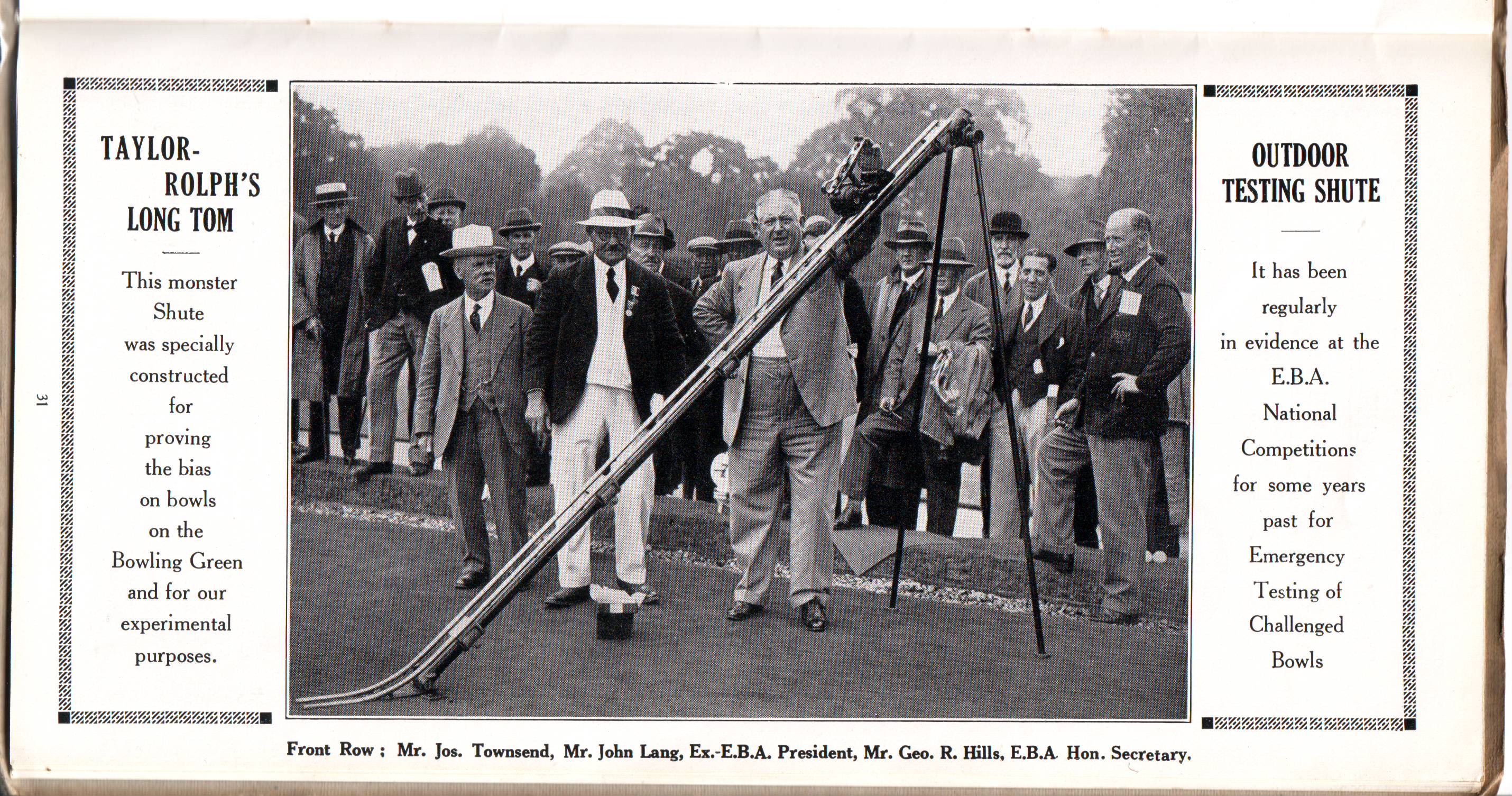
The picture is taken from 1935 Taylor-Rolph price list. It is
worth noting that it was also used for the emergency testing of
'challenged' bowls
When the writer visited New Zealand in the mid 1980's their only
method of testing was to use a chute and the picture below shows
the chute used at a Dunedin green. It was not until 2002 that a
World Bowls Ltd. licensed test table was set up in New Zealand.
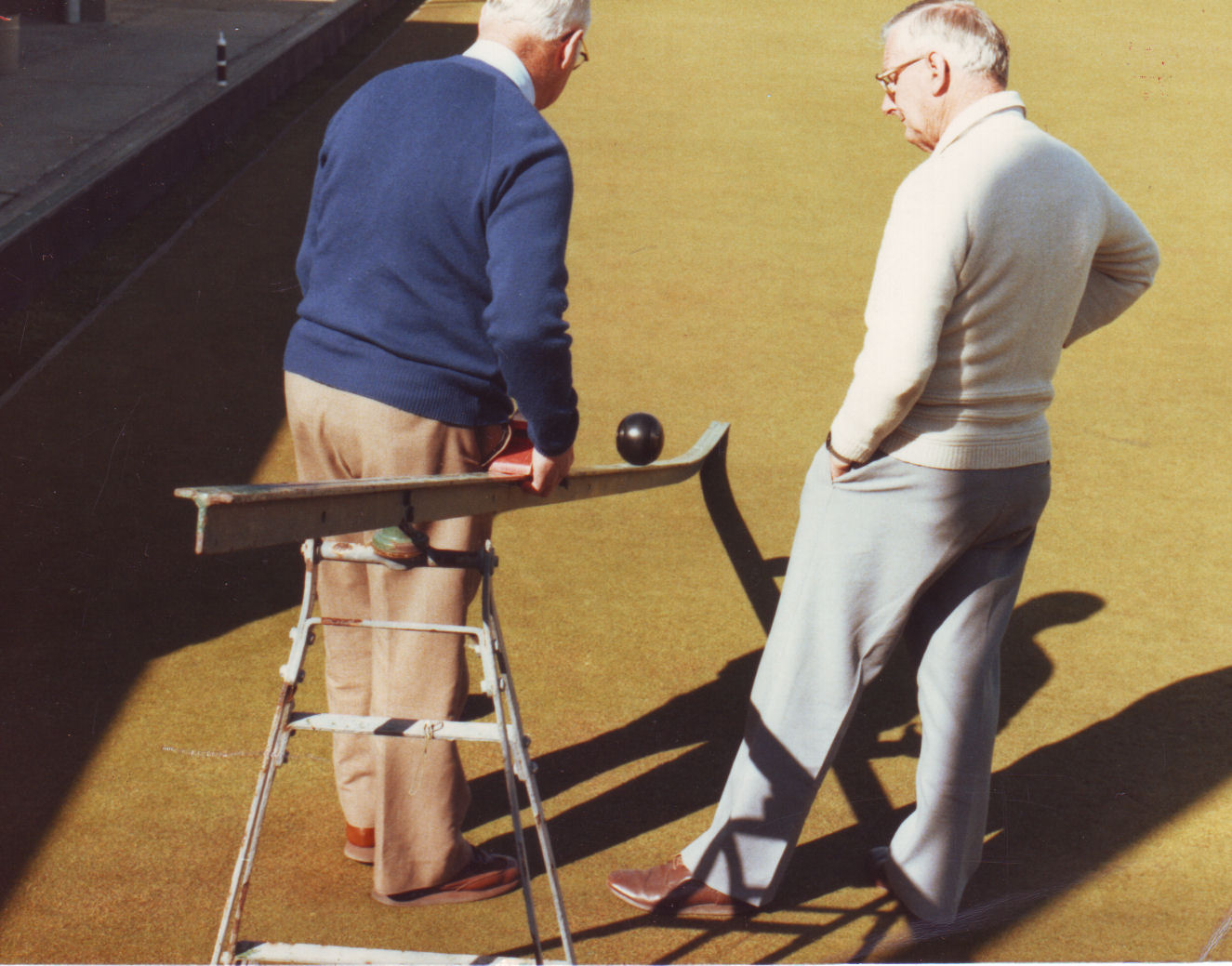
The following picture was published in the Queensland Bowler
magazine in September 1998 and shows that some green testing was
also carried out in Australia
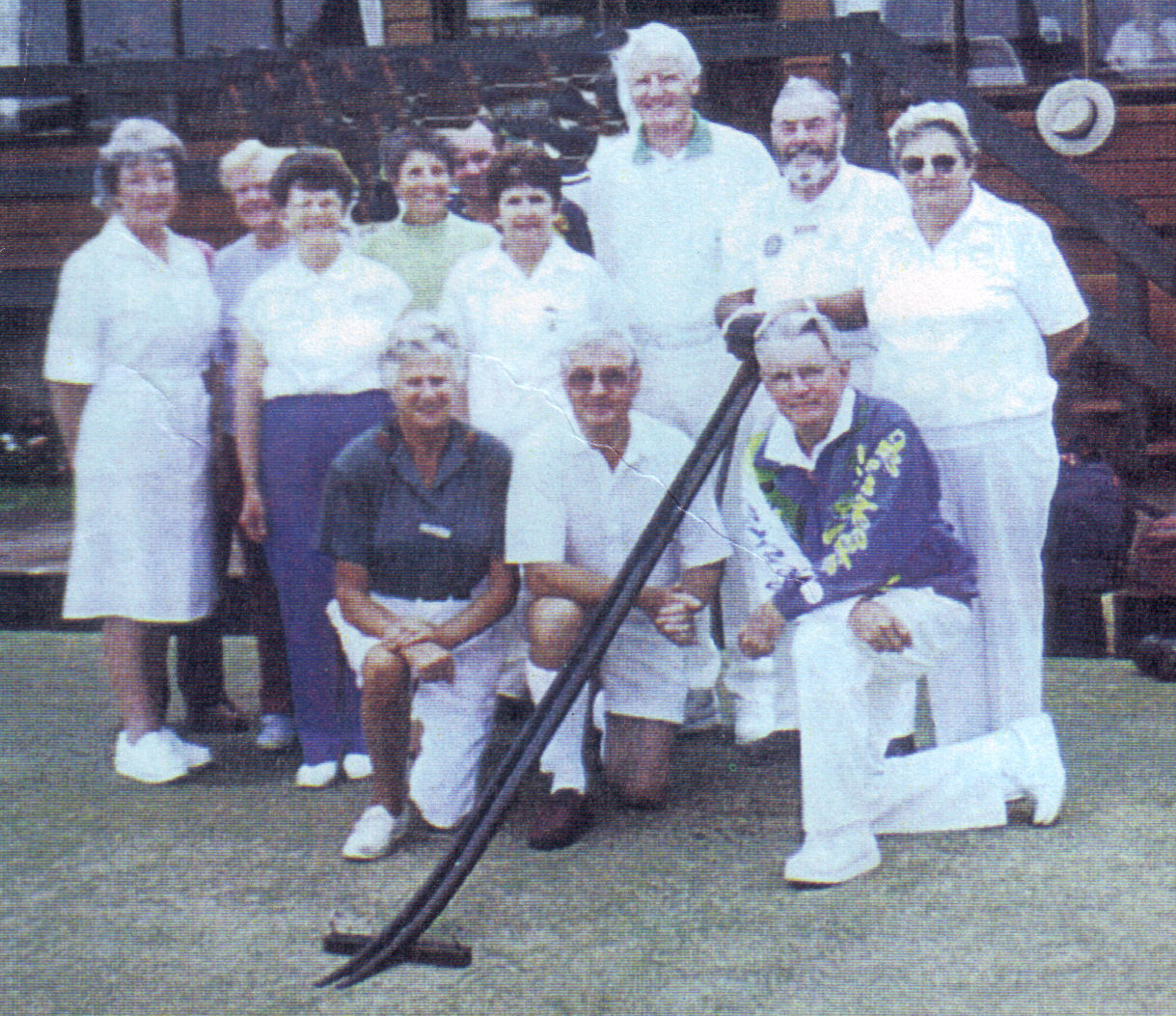
However, one very important point that affects the bowls
performance, is the bowlers own style of delivery. An example I now
regularly use is from a visit to Australia when I was called over
to a green by two players. They were both playing Drakes Pride
bowls, size 5 heavyweight, one with a grip and one that was plain,
and I was asked why the grip bowls took less land than the plain. I
naturally replied that it was not true, so they bowled the two sets
and sure enough the grip bowls took about 14" - 18" less land. This
I had to admit did cause me some surprise and so I asked them to
swap their sets and bowl again. This time, it was their turn to be
surprised to find that the plain bowls now took 14" - 18" less land
than the gripped. The only thing that has changed was the bowler,
and whilst a trained coach might well have been able to spot what
was the difference between their deliveries, I could not. The
results just confirmed that the bowlers themselves make a
difference to the bowls performance, not just the work that we
manufacturers do.
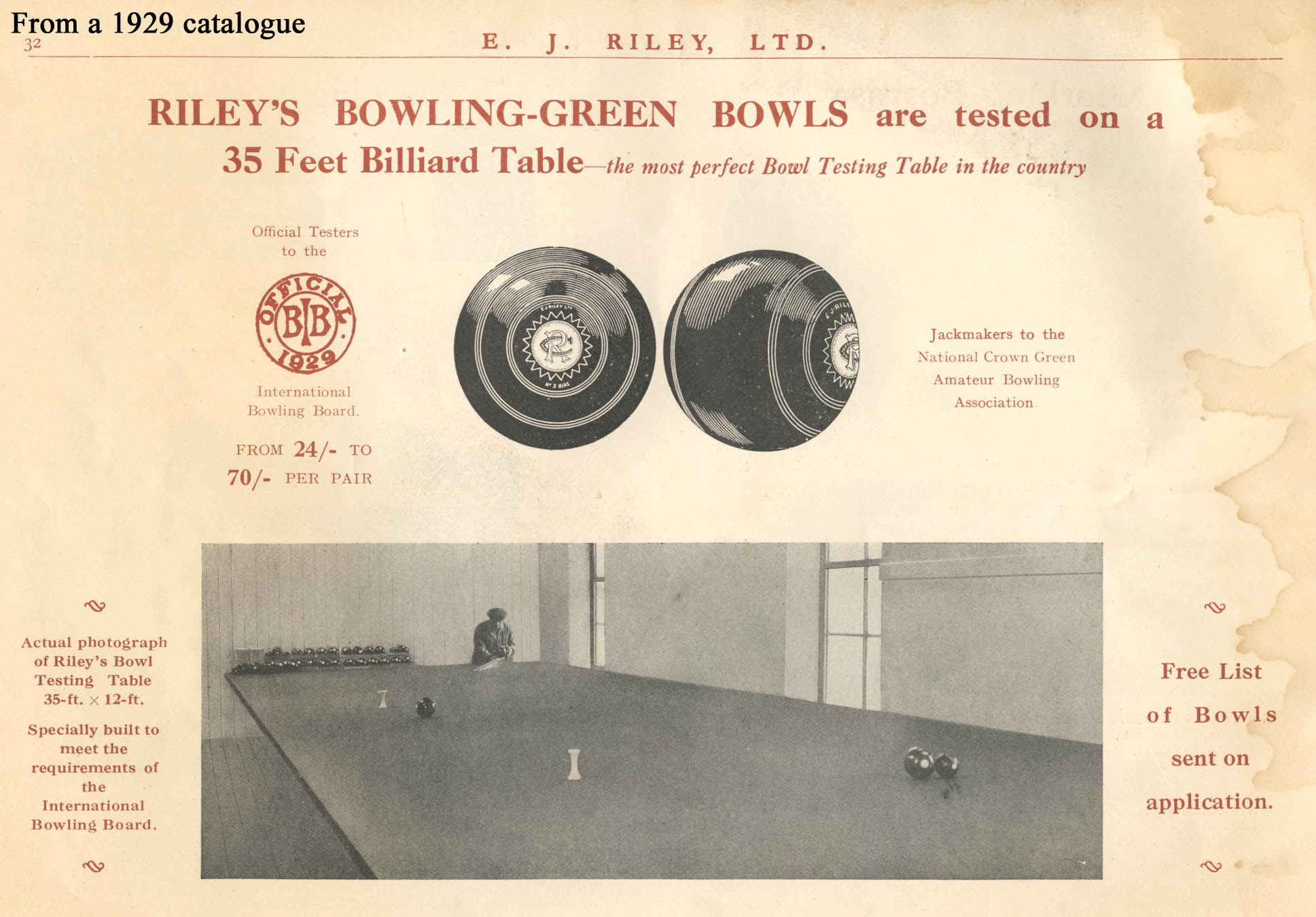
The picture above is from a 1929 catalogue and shows a 35ft x
12ft Bowls test table. It must have been made from 6 full size
billiard tables. Note also the International Bowls Board stamp with
a 1929 date stamp.
In April 2002 World Bowls Ltd. introduced a revised Working
Referance Bowl at the same time as establishing a standard test
table surface, a standard release chute,
a WorkingReference
Bowl (WRB) and Test Regulations to be followed.
The 2002 Regulations are not too dissimilar to the 1928 formula, or
the previous 1986 Guidelines although the test distance is now 9
metres. World Bowls Ltd. have a specified delivery chute which must
be used and also inspect the test tables every year and at the
inspection exchange the Working Reference Bowl that is issued to
the tester / manufacturer.
Frequently asked questions
about Lawn Bowls
Question. I have a set of
Lignum Vitae (wooden) bowls can they be re-stamped ?
Answer. World Bowls have tightened up their
regulations and it is now unlikely that Lignum bowls will conform
to those regulations. However the bowls can still be renovated and
used in social games despite not being stamped.
Question. The date stamp on my
bowls has expired, do I really need them to be re-tested
?
Answer. The World Bowls
'stamp' and its predecessor World Bowls Board 'stamp' have a ten
year life, which includes the year of its test. So basically by
their regulations the answer is, yes it should be re-tested. The
main reason for doing the re-test is that part of the work done
checks that the set is still running as a set. After all given ten
years of wear and tear the bowls must have suffered abrasion and
knocks. So it is in your interest to have them checked
out.
Question. My bowls have no
emblems, are they legal?
Answer. This question
basically only relates to sets sold in the UK prior to 1996, when
emblems were not required in the UK. Even now it depends on what
level you are playing at to know if emblems/engraving is required
for play in the UK. This needs to be considered and advised to the
tester when you submit your bowls for test. Currently (2009 - still
true in 2013) the World Bowls Ltd. testers licence states ' Bowls
may display- Engravings (emblems)'. However, the manufacturers
licence requires all sets to have engraving (emblems), so all new
sets of bowls will have emblems.
For club and even inter club
competitions bowls without emblems are ok. If however the
competition is under the auspices of World Bowls Ltd. or the
Professional Bowlers Association the you will find that sets of
bowls must have emblems. So to be safe it is probably best to have
emblems/engraving.
THURSTON can engrave emblems
on to most makes of bowl and would suggest that this work is
carried out at the same time as the set is tested.
Question. I've decided to have engraving on my
bowls, can I have my initials and an emblem?
Answer. The answer is yes, but with
reservation. As long as the initials are all on the same side eg.
on the bias side and the emblem on the non bias side. Then the
sets, basically, conforms to World Bowls Ltd. regulations and will
be acceptable in the UK. Most other counties require that the
emblem would be the same, but proportional in size, on the bias and
flat side of the bowls.
THURSTON recommend that the
emblems/engraving be the same on both sides which avoids any
possible future problems.
Question. I play outdoors what weight of bowl
should I use?
Answer. If you only play outdoors and play in the U.K.,
then a medium weight bowl is probably the best. The reason being
that most U.K. outdoor greens are slow / heavy and a medium weight
bowl will have some chance to show its bias. If you were to use an
Indoor style and or heavyweight model the slow / heavy greens will
kill the bias before it has a chance to show.
Question. I play both Indoor and Outdoor do I
really need to different sets of bowls ?
Answer. The previous answer has some bearing on
this one. However there are some models of bowl (eg Professional by
Drakes Pride) that have medium bias and many bowlers find they
perform acceptably both on outdoor and indoor greens. Most
manufacturers do however produce models suited to either outdoor or
indoor use. Note. If outdoor model bowls are used indoor they will
tend to run into the next rink and so you might not be able to play
certain hands. If indoor models are used outdoor they will show
little or no bias and reduce the game to playing up the middle.
Perhaps this is what causes complaints about bias strength
?
Question. What size of bowls should I
use?
Answer. The 'old' idea was to use the largest
size you possibly could, or that if you can span the circumference
of the running sole with your two hands then that size would be
right.
However the simple answer is
whatever size feels comfortable in the hand. So when selecting a
set of bowls try a few sets. Perhaps start with a size 3 try a few
'pretend' deliveries. Does it cause any strain to your wrist? Does
it feel that you need to adjust /tighten you grip in the back
swing? Does out fall out of your hand!? If it all feels ok then
perhaps try a size 4 or even larger, but if there is discomfort go
down the sizes until you are comfortable.
Also there are some models'
which are not as broad, such as the Drakes Pride Professional
model. Such models might allow you to use a bigger bowl
comfortably, so also try a few types of bowl in a size if you
can.
Question. I
have two sets of the same make and model of bowl one set
is red the
other is green. I am
told they are the same bias but I find they take a different line -
whose is right?
Answer
. Speak to any of the top bowlers and
they will agree that the different coloured sets perform
differently and yet when seen on the bowls test table they run the
same. The only answer that seems to have any merit is that subtle
but significant differences in how the player grips the bowl and
thus how they deliver. Are probably caused by affect that the
different colour dyes used in the powder mix used for moulding
bowls has on the final surface finish.
Question. My
set of size 4 heavy bowls weigh more than my friends set, why is
their a difference?
Answer. We
assume that the sets are different models or are from different
manufactures. As each manufacturer uses the specific gravity of
moulding powder that they favour for their quality. So there are
likely to be weight differences between different manufactures
sets. Also there is likely to be differences between models as
there are some that are slim line, so slightly less material, and
some which 'fill the hand', which will have a little more material.
So between different models from the same manufacturer there will
be different weighs, even if both are marked up as 'heavy', for the
same size bowl. The
weight chart shown below should therefore be used as a rough guide
only.
Question.
It looks like they have painted
the grips on their bowls, surely this effects the bais and is it
allowed?
Answer. Law 8.6 deals with alterations to bias
of bowls which is illegal and has sever penalties. However point 4
states .. Players or owners who colour the groove rings or dimples
on a bowl for decoration are not breaking the
law.
This size/weight table is an
approximate guide to weights and sizes of lawn bowls, each
manufacturer and each model will be somewhat different. These
figures are only for guidance and are an average across a range of
models & makes.
-
|
Size.
|
Dia
|
Medium weight
|
Heavy Weight
|
Extra Heavy
|
|
00
|
116 mm
|
1.19 kg
|
1.25 kg
|
1.27 kg
|
|
0
|
118 mm
|
1.22 kg
|
1.28 kg
|
1.30 kg
|
|
01
|
119.5mm
|
1.28 kg
|
1.33 kg
|
1.36 kg
|
|
1
|
121mm
|
1.30 kg
|
1.35 kg
|
1.40 kg
|
|
2
|
122.5mm
|
1.35 kg
|
1.40 kg
|
1.44 kg
|
|
3
|
124mm
|
1.40 kg
|
1.46 kg
|
1.50 kg
|
|
4
|
125.5mm
|
1.46 kg
|
1.52 kg
|
1.55 kg
|
|
5
|
127mm
|
1.52 kg
|
1.58 kg
|
n/a
|
|
6
|
128.5mm
|
1.58 kg
|
n/a
|
n/a
|
|
7
|
130mm
|
1.58 kg
|
n/a
|
n/a
|
Unless otherwise stated the pictures used and scans are
copyright to E.A. Clare & Son Ltd.
© Peter Clare 2009 - © E.A. Clare & Son Ltd. 2018 -
reproduction of article allowed only with permission from E.A.
Clare & Son Ltd.
